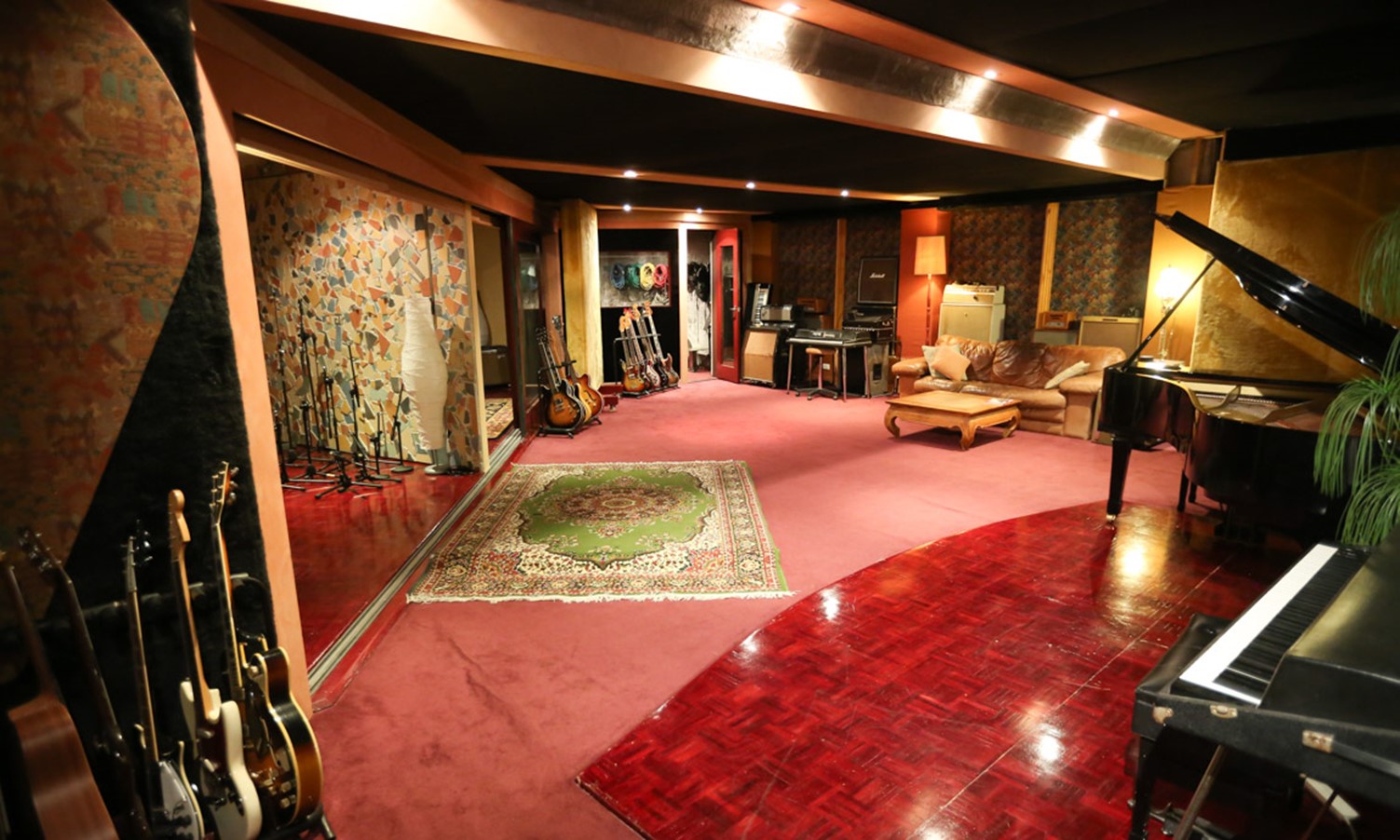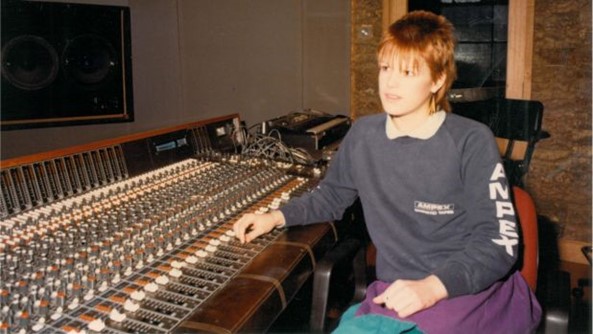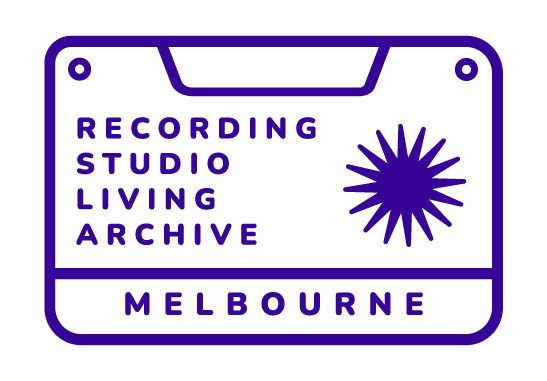SING SING, PLATINUM, KISS, MEDIASOUND, BEA
(1960’s-current)
Upholding the legacy
Sing Sing is a renowned local recording studio into its fourth decade of operation. Founded by Kaj Dahlstrom who moved to Australia from Sweden with his parents at the age of 15. They initially lived in Queensland where he was playing in bands before relocating to Melbourne. Dahlstrom built a studio in 1975 in a rental house in East Melbourne to record his own music and friend’s bands. At this stage, he was working for Armstrong’s driving the audio truck sent out for location recordings recording live shows with Ern Rose and Roger Savage.
Dahlstrom acquired an 8-track machine from Armstrong’s and installed this in his home studio. Within a few years, recordings had outgrown the home space and in 1980 he found a room in a warehouse that was running rehearsals in an old Nuttelex margarine factory at 1-3 Gordon St Richmond/Cremorne. Dahlstrom hired the adjacent rehearsal rooms as tracking space for his small control room, and over the years as business grew, the recording studio gradually took over the entire complex. The original small room the studio initially occupied became a storage space as the studio expanded to full capacity.
Renamed Sing Sing in 1983 when new business partners came on board, this studio housed production for countless culturally significant releases in popular music as well as film soundtracks. Many high-profile engineers and producers active in Melbourne since the 1980’s in Australia have worked on projects in this space. Early major releases include The Black Sorrows, Cosmic Psychos, Boom Crash Opera and Painters & Dockers and the vocals for Kylie Minogue’s “Locomotion” which had other production completed at Platinum in Chapel St, South Yarra (later to become a second premises for Sing Sing).
With a similar philosophy to Bill Armstrong of having the best equipment and technology and providing a comfortable environment to work in, Sing Sing Cremorne quickly developed a reputation as one of the top inner-city studios in Melbourne. It attracted high profile local talent as well as visiting international artists and production personnel. It provided an enormous selection of quality audio equipment along with extras such as a table-tennis room, games room, lounges and green rooms to make artists feel at home. Sing Sing became a studio of choice for many including Tony Cohen who is seen wearing a Sing Sing studio t-shirt throughout his interviews on the Long Way to the Top ABC television series 2001.
Sing Sing South- First floor, 643 Chapel Street, South Yarra (1998-current)
In 1998 Dahlstrom and his business partners expanded Sing Sing to take over the lease of a second premises on Chapel St which had been operating briefly as Kiss studios and prior to that that as Platinum. It became known as Sing Sing South or ‘Studio B’. This site has a long audio history dating back to 1967 when the Broadcast Exchange of Australia (BEA) constructed the second level of the building. Since this time, the studio studio has had continual use as a dedicated recording space under several different transitions and ownerships. It has produced some of Australia’s most commercially successful recordings and continues to do so today with Sing Sing still operated by founder Kaj Dahlstrom and his partner Jude Coleman from these premises. With now 60 years of recording history, this space is the earliest purpose-designed and continually operating recording studio in Melbourne still running today.

Broadcast Exchange of Australia-Mediasound
Established in the 1930’s at 32 Market St in Melbourne’s CBD the BEA focused on recording radio drama series and advertising commercials and was the first occupancy of the upper level of 643 Chapel St when it relocated there in 1967. The second level was constructed as a recording space just prior to BEA’s move and features an early acoustic treatment technique of lining the walls in lead sheeting as a sound barrier. The concrete floor also floats above a layer of fiberglass that helps reject low frequency rumble from trams and other street noises. The BEA was renamed Mediasound in the late 1970’s to better reflect the services of the business which by that time was mainly focused on providing sound for the audio-visual industry. The studio engineer was radio actor Monty Maizels who was influential to a young Dave Flett (see chapter 3) in learning music recording techniques.
Yarrabank (1981-c.1982)
In the late 1970’s Mediasound sold the business which was renamed Yarrabank studios. Graeme Thirkell (see chapter 1) was commissioned to redesign the studio and constructed a live-end/ dead-end room which was significantly different to the Westlake design style popular at the time and likely Australia’s first of this style. Working in this space, engineers could record both reverberant reflective sounds in the live area or a more controlled and dampened sound in the dead-end space. The fashion of using dampened spaces was significant in the trend towards capturing highly isolated audio signals that could be later manipulated with effects. This trend for achieving a more controlled sound using close-microphone placement in audio production began appearing in the late-1970’s and 80’s. This technique aims to minimise room reflections or spill from other instruments for the highest level of control in post-production and coincides with advances in studio equipment technology where a clean signal is preferable when adding effects and manipulating the original sound.
Platinum (c.1982-1996)
Rumoured to have gone broke, Yarrabank studios changed hands in the early 80’s with Graeme Thirkell being offered the studio business as payment for his work. Partnering with Ian McKenzie, a producer and engineer from Armstrong’s/AAV, the studio became known as Platinum and began to attract clients of a similar profile to Sing Sing and AAV. Personnel and artists moved between studio spaces with a shift towards more freelance production activity than full-time employment at studios. Album credits for Platinum often share recording credits at various locations such as AAV, Eaton’s, Sing Sing, Platinum and Rhinocerous in Sydney. Big name artists started to flow through the doors at Platinum with albums like Marvin the Album by Frente, Pseudo Echo’s- Funky Town single, some of Goanna’s-Spirit of Place and artists such as Kids in the Kitchen, Uncanny X-Men and Mondo Rock, firmly cementing 643 Chapel St in Australian popular music history.
A new studio section was added to the East end of the building in the early 80’s when Chris Corr came across to work as an engineer at Platinum from Richmond Recorders. This east wing studio was re-designed by studio designer Dave Flett (see also Chapter 3) who had also designed Richmond Recorders. As a teenager Flett had spent time at 643 Chapel St same building when it was operating as Mediasound soaking up knowledge audio knowledge with BEA engineer Monty Maizels.
The sound of the 80’s had really begun to take hold with the introduction of digital effects and new developments in audio technology. Based on making the most of rapidly developing technologies and new approaches to recording, including the introduction of digital samplers and drum machines, the sound of popular music began to change. Keyboards and synthesizers had developed as a standard technology and synthetic sounds were being integrated with organic sounds. Drum machines had arrived making drummers fearful that these machines would leave them out of a job. Production techniques featuring close-miking by placing microphones on each individual component of a drum kit and adding exaggerated digital reverb, delay and time-based manipulation for creative effect was a popular trend. This sound was so fashionable that Corr describes a period in the 1980’s where in an ironic twist of the impact of technology on music-making were he was required to make acoustic drum kits sound like drum machines.
One engineer who worked at Platinum and who would go on to record and shape the sounds of some of the top international hits of the 80’s at Stock Aitken Waterman in the UK was Karen Hewitt. Lured to Melbourne by its reputation as a music city with cutting edge recording equipment and a desire to work with the best in the business, this young engineer came to Melbourne after cutting her teeth at the Sydney studio Albert’s. With ambitions of learning acoustic design and electronics from audio pioneer Graeme Thirkell, she landed a job working in his electronics company Optronics and soon after began recording at his new studio.

Kiss studios (1996-1998)
Platinum operated until 1995 until it changed hands once again, this time operating as the short-lived Kiss. Meanwhile, Sing Sing in Cremorne/Richmond was thriving and Dahlstom and partners decided to expand their business and operate from two locations where Sing Sing remains to this day.
Farewell to Sing Sing- Cremorne/Richmond (1980-2017)
In 2017 Sing Sing, Cremorne/Richmond, one of the longest running significant spaces in Melbourne recording studio history finally closed its doors. The studio was recently dismantled after years of acoustic refinement and a 37-year history of outputting some of the most important Australian releases during that time. As a reminder of the vulnerability of these culturally significant spaces, the studio was forced to vacate due to pending development by new landlords. This site is in planning for development into apartment towers.
Current Sing Sing, South Yarra is also a significantly vulnerable cultural space with a history of 60 years as a studio since built by the Broadcast Exchange of Australia. This is the oldest purpose-built recording studio for popular music release still in-tact and in use in Melbourne today. Despite it’s incredible history, the surrounds of Chapel Street are rapidly giving way to development. During an interview with business owners Kaj and Jude Dahlstrom at 643 Chapel Street, cranes and demolition equipment pounded through concrete only a few doors away in construction of a multi-story tower. As a rental space, it is only a matter of time before development of this piece of Melbourne music history is threatened by Melbourne’s rapid development, and with a fairly nondescript facade, it is unlikely to be considered for heritage protection.
REFERENCES
Artists recorded at Sing Sing include: Australian: Airborne, The Avalanches, Augie March, Jimmy Barnes, Blue King Brown, British India, John Butler Trio, the Badloves, The Cat Empire, Nick Cave & the Bad Seeds, Judith Durham, Eskimo Joe, Bob Evans, Renee Geyer, Slava Grygorian, Missy Higgins, Ruby Hunter, Hunters & Collectors, Paul Kelly, The Living End, Midnight Oil, Powderfinger, Archie Roach, Something For Kate, Angus & Julia Stone, The Temper Trap, Ross Wilson and more.
International: Amanda Palmer, Black Eyed Peas, Cat Power, Elvis Costello, Kanye West, Kiss, Lady Gaga, Mariah Carey, Mark Ronson, Split Enz, The Killers, The Mars Volta, The Prodigy and more
Jude Dahlstrom and Kaj Dahlstrom interviewed by Lilith Lane 2017, sound recording (Latrobe University, 8 September 2017)
Sing Sing official website, (2017),
Paul Clarke-producer, ‘Long Way to the Top’, (ABC-Television, six-part series 2001) Eps. 5 & 6.
‘Jude Dahlstrom and Kaj Dahlstrom interviewed by Lilith Lane’
The next longest running continuous studio would be Allan Eaton’s in St Kilda, or Bakehouse Lane Studios, North Fitzroy (formerly York St Studios) both of which have maintained operation as music recording studios since the mid-1970’s. Eaton’s is used largely for film and television recording.
‘Monty Maizels interviewed by Lilith Lane’, sound recording (unpublished Latrobe University, 1 October 2017). Monty Maizels was an engineer for BEA from March 1953 to August 1967.
Philip Newell, ‘Recording Studio Design’, Focal Press-Elselvier, Amsterdam (2003) p.xxiv
‘Karen Hewitt interviewed by Lilith Lane’, sound recording (unpublished Latrobe University, 12 September 2017)
Ibid. Hewitt’s first session as a teenager at Albert’s was assisting producer Mark Opitz (The Angels, AC/DC, INXS, Divinyls) recording Loaded Dice (1979). Her second was recording the Reels (1980) to fill-in for Tony Cohen who had been detained at Sydney airport on drug charges.
Platinum Studios artists recorded: Goanna, Pseudo Echo, Kids in the Kitchen, Uncanny X-Men, Not Drowning Waving, Models, Real Life, Mondo Rock, Boom Crash Opera, Joe Camelliri, Little River Band, The Cahantoozies, Kylie, Crowded house, Painters and Dockers, Prince, TISM, Paul Kelly, Crowded House, Hunters & Collectors, Kate Cebrano, Stephen Cummings and more.
‘Chris Corr interviewed by Lilith Lane’, sound recording (unpublished Latrobe University, 15 August 2017)
‘Dave Flett interviewed by Lilith Lane’, sound recording (unpublished Latrobe University, 26 September 2017)
‘Chris Corr interviewed by Lilith Lane’, sound recording (unpublished Latrobe University, 15 August 2017 )
‘Karen Hewitt interviewed by Lilith Lane’
‘Women in the Victorian Contemporary Music Industry’, Music Victoria, (September 2015)
Interview with John French, Interview with Karen Hewitt, Interview with Doug Brady. Discuss Hewitt’s early sessions in Sydney with Opitz and Cohen story.
Anna Laverty
Ballantyne, Adrian, ‘From Kanye to can’t stay: Sing Sing Studios site sold.’, realcommercial.com.au, (11 February 2016),
Ibid.
Staff Writer, ‘Over-development ‘threatens Melbourne’s character’’, ABC News, 31 Dec. 2017,
